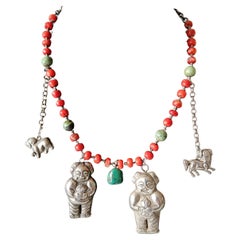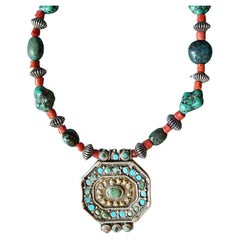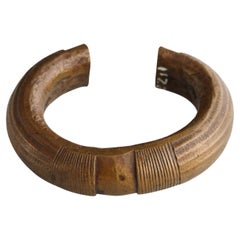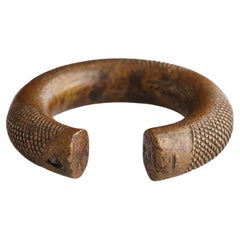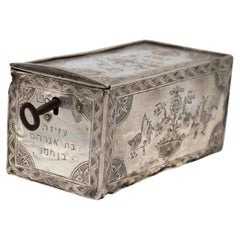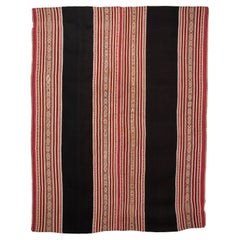Mid-19th Century Tribal Art
to
16
5
33
1
44
218
1,128
29
447
438
78
8
4
20
28
19
33
34
23
17
4
15
14
6
4
3
16
12
11
11
11
33
33
33
1
Period: Mid-19th Century
Rare Antique Qing Dynasty Chinese Ethnic Minority silver Coral necklace
Located in London, GB
A beautiful rare Antique Qing Dynasty Chinese Ethnic Minority silver Coral turquoise necklace from Yunnan.
A superb chain necklace with added Taoist charms with turquoise and fine r...
Category
Chinese Antique Mid-19th Century Tribal Art
Materials
Coral, Silver
Antique Tibetan Gau Box Silver Turquoise pendant necklace
Located in London, GB
Ga`u Box necklace with silver with Turquoise inlay with coral and turquoise beads
All Tibet/ Himalaya mid 20th century
Category
Tibetan Antique Mid-19th Century Tribal Art
Materials
Brass
Bronze Currency Bracelet/Manilla, Dogon People, Burkina Faso, 19th c. - No 2
Located in Aramits, Nouvelle-Aquitaine
19th-century bronze currency bracelet / Manilla in horseshoe form with fixed opening. Intricate graphical design with lines and accent points on the top and at both tips. This type o...
Category
Burkinabe Tribal Antique Mid-19th Century Tribal Art
Materials
Brass
Bronze Currency Bracelet/Manilla, Dogon People, Burkina Faso, 19th c. - No 3
Located in Aramits, Nouvelle-Aquitaine
19th-century bronze currency bracelet / Manilla in horseshoe form with fixed opening. Intricate graphical design with a lattice pattern. This type of bracelet was worn or used by the...
Category
Burkinabe Tribal Antique Mid-19th Century Tribal Art
Materials
Bronze
extremely rare Algerian Judaica silver, jewish Dowry box early 19th century
Located in Tel Aviv - Jaffa, IL
Amazing and scarce JUDAICA object, we have here one of the most touching jewish objects we had for a long time, this small silver dowry box was made in Algeria in the early 19th century, it is all covered with symbols of jewish faith and of couples, the sliding lid has 2 flanking birds with hamsa (protective hand) on each side and a flower vase in the middle.
one side shows two flanking lions with a tree in the middle and the other side shows again two big and two small birds with a flower bowl in the middle, front side has a key hole and next to it there is the Hebrew inscription ס״ט״" which says Siman tov or in English "a good sign" it is taken from the wedding blessing, underneath the lock there is another inscription with the name ״עזיזה בת אברהם בן חמו״ which is the name of the bride, her father and her grandfathers name.
the box is full marked a lot of times with the silversmith mark, every side of the box is marked.
this box was probably ordered by the grooms family to hold the jewelry they are giving to the bride as dowry, this type of objects are rare and there are just a few of them on museum collections.
DOWRY (Heb. נְדֻנְיָה), the property a wife brings to her husband at marriage; the Yiddish equivalent, nadn, is from the same root. The custom of nedunyah became clearly defined and institutionalized only in the talmudic period. In biblical times, mohar (מֹהַר), whereby the groom bought his wife from her father (Gen. 24:53; Ex. 22:15–16; Hos. 3:2), was the accepted practice. It was then customary that the groom give the bride gifts, and that she bring certain property to her husband's home upon marriage: slaves, cattle, real estate, etc. (cf. Gen. 24:59–61; 29; Judg. 1:14ff.; I Kings 9:16). Evidence of the custom of nedunyah is to be found in Tobit (7:14; 8:21) and in the Assuan papyri (Cowley, Aramaic, nos. 15, 18). Gradually, mohar was superseded by the ketubbah custom according to which the husband merely assumed the responsibility of compensation to his wife in case he divorced her: he had to pay her 200 zuzim if she had been a virgin at the time of marriage, and 100 zuzim if a widow or divorcée (see *Ketubbah).
By talmudic times, the institution of nedunyah was prevalent; the father gave a dowry to the bride since the daughter was excluded from paternal inheritance. Fifty zuzim (equivalent to the worth of 180 grams of silver) was the minimum amount a father was obliged to give to his daughter (Ket. 6:5). Parents usually gave much more, according to their social standing. Community funds provided the dowry for an orphan or a very poor girl (ibid.; cf. Sh. Ar., YD 251:8). In case of her father's death, the brothers of a minor girl were obliged to give her the minimum dowry, and the court estimated how much her father would have given her above the minimum dowry. The sum was then taken out of the father's estate and given to the daughter upon majority (Ket. 6:6; 68a–69b). In the absence of such an estimate, each daughter was entitled to receive one-tenth of the value of her father's estate in money, or in valuables (Yad, Ishut, 20:4–7; Sh. Ar., EH 113:4). If the father was unable or unwilling to pay the promised dowry at the betrothal ceremony, the groom could refuse to marry his bride (Ket. 13:5; Ket. 108b–109a). Insistence on exact payment of the promised dowry, however, was frowned upon by later rabbinic authorities (Rema to Sh. Ar., EH 2:1). In certain communities it was customary for the groom's father to make a dowry contribution equal to that of the bride's father (Ket. 102b). The dowry, whether given in real estate, slaves, money, or chattel was recorded in the marriage contract (the ketubbah) and in some instances one-third or one-fifth of the actual value of the dowry was added to the sum mentioned in the ketubbah. Based upon a decree enacted by *Simeon b. Shetah (first century C.E.), the Talmud ruled that the husband and his entire property were liable for compensation as stipulated in the ketubbah, either in case he died (when she collected the sum specified in the ketubbah from the heirs) or in case he divorced his wife (Ket. 82b). For the status of the dowry and the husband's rights and obligations, see below. The rabbinic enactments (Takkanot Shum) by R. Jacob *Tam and by the rabbinic synod of the communities of Speyer, Worms, and Mainz (Germany) stipulated that if a woman died...
Category
Algerian Antique Mid-19th Century Tribal Art
Materials
Silver
Antique Aymara Woman’s Mantle (Ahuayo), Bolivia
Located in Point Richmond, CA
Antique Aymara Woman’s Mantle (Ahuayo), Bolivia
A large, finely woven and intricately patterned woman’s mantle from the Pacajes region of Bolivia displaying three wide vertical sect...
Category
Bolivian Tribal Antique Mid-19th Century Tribal Art
Materials
Alpaca
31 Brazilian Silver Amulets
Located in New York, NY
These 31 Brazilian amulets, or balangada, were hammered from sheets of silver in the 19th century to form pomegranates, sugar apples, guava, and other...
Category
Brazilian Folk Art Antique Mid-19th Century Tribal Art
Materials
Silver
$8,500 / set
19th Century Balinese Temple Offering Tray / Bowl 'Dulang' with Polychrome
Located in Jimbaran, Bali
Balinese offering tray; "Dulangs" served two main purpose, one purpose was to carry offerings atop woman’s heads during ceremonies. The present "Dulang" was used exclusively in temples to display offerings and features hints of turquoise polychrome at its base. This "Dulang" has faded polychrome and chipped...
Category
Balinese Other Antique Mid-19th Century Tribal Art
Materials
Wood
Bronze Currency Bracelet/Manilla, Dogon People, Burkina Faso, 19th c. - No 5
Located in Aramits, Nouvelle-Aquitaine
19th-century bronze currency bracelet / Manilla in horseshoe form with fixed opening. Intricate graphical swirled rope work design and tips are shaped with large flat ends with geome...
Category
Burkinabe Tribal Antique Mid-19th Century Tribal Art
Materials
Bronze
Bronze Currency Bangle/Manilla, Oromo People, Burkina Faso, Ethiopia, 19th C.
Located in Aramits, Nouvelle-Aquitaine
19th-century bronze currency bangle / Manilla with a fixed opening. Minimalist, simple design work with engraved geometrical circles and lines.
This type of bracelet was used and wor...
Category
Ethiopian Tribal Antique Mid-19th Century Tribal Art
Materials
Bronze
Bronze Currency Bracelet/Manilla, Dogon People, Burkina Faso, 19th Century
Located in Aramits, Nouvelle-Aquitaine
19th-century bronze currency bracelet / Manilla in horseshoe form with fixed opening. Intricate graphical swirl design and tips are shaped with large flat ends with 5 beads on each s...
Category
Burkinabe Tribal Antique Mid-19th Century Tribal Art
Materials
Brass
Antique Ghee Serving Jug, Indian, Tribal, Libation Cup, Candle Nozzle, Victorian
Located in Hele, Devon, GB
This is an antique ghee serving jug. An Indian, hardwood tribal libation cup or decorative candle nozzle, dating to the mid Victorian period, circa 1860.
Fascinatingly naive treen...
Category
Indian Tribal Antique Mid-19th Century Tribal Art
Materials
Hardwood
Antique Crow Beaded Knife Sheath, circa 1870, Native American Plains
By Crow
Located in Denver, CO
This exceptional Crow (Apsáalooke) beaded knife sheath, dating to circa 1870, is an outstanding artifact from the Classic Period of Native American artist...
Category
American Native American Antique Mid-19th Century Tribal Art
Materials
Hide
Rare Kanak "kagu" Wooden Bird Beak Puzzle, New Caledonia, 19th Century
Located in NICE, FR
Rare Kanak war club of the "Kagu" type (Bird's beak) in hardwood, from New Caledonia, Melanesia, 19th century.
This is an exceptional Kanak art collector's item due to its imposing ...
Category
New Caledonian Antique Mid-19th Century Tribal Art
Materials
Wood
Bronze Currency Bracelet/Manilla, Beri People, Sudan, 19th Century - No 1
Located in Aramits, Nouvelle-Aquitaine
Early to mid-19th-century bronze currency bracelet / Manilla in circle form. Intricate graphical geometrical. This type of bracelet was worn/used by the Zaghawa People also called Bé...
Category
Sudanese Tribal Antique Mid-19th Century Tribal Art
Materials
Bronze
Antique Hand Carved Pouring Dish, Indian, Hardwood, Serving Pot, Victorian, 1850
Located in Hele, Devon, GB
This is an antique hand carved pouring dish. An Indian, hardwood serving pot, dating to the early Victorian period, circa 1850.
Eye-catching tribal appeal to the naive carved fini...
Category
Indian Tribal Antique Mid-19th Century Tribal Art
Materials
Fruitwood
Bronze Currency Bracelet/Manilla, Beri People, Sudan, 19th Century - No 2
Located in Aramits, Nouvelle-Aquitaine
Early to mid-19th-century bronze currency bracelet / Manilla in circle form. Intricate graphical geometrical. This type of bracelet was worn/used by the Zaghawa People also called Bé...
Category
Sudanese Tribal Antique Mid-19th Century Tribal Art
Materials
Bronze
19th Century Berber Scarf
Located in Brecht, BE
A very rare find this mid 19th century unique berber scarf, sublime natural dye colors.
Category
Moroccan Antique Mid-19th Century Tribal Art
Materials
Wool
19th Century Balinese Temple Offering Tray / Bowl 'Dulang'
Located in Jimbaran, Bali
Balinese offering tray; "Dulangs" served two main purpose, one purpose was to carry offerings atop woman’s heads during ceremonies. The present dulang was used exclusively in temples to display offerings. This dulang has faded polychrome and chipped wood...
Category
Balinese Other Antique Mid-19th Century Tribal Art
Materials
Wood
Lombok Tribal Tray / Bowl 'Dulang' / Small Table
Located in Jimbaran, Bali
This is a large 'Dulang' from Lombok. Dulangs amid Indonesia serve a number of purposes depending on the region they originate from. In Lombok 'Dulang' Tray were used as small tables...
Category
Balinese Other Antique Mid-19th Century Tribal Art
Materials
Wood
Lombok Tribal Tray / Bowl 'Dulang' / Small Table
Located in Jimbaran, Bali
This is an exceptionally large 'Dulang' from Lombok. Dulangs amid Indonesia serve a number of purposes depending on the region they originate from. In Lombok 'Dulang' Tray were used ...
Category
Balinese Other Antique Mid-19th Century Tribal Art
Materials
Wood
Bronze Currency Bracelet/Manilla, Dogon People, Burkina Faso, 19th c. - No 4
Located in Aramits, Nouvelle-Aquitaine
19th-century bronze currency bracelet / Manilla in horseshoe form with fixed opening. Intricate graphical swirl design and tips are shaped with large flat ends with cross pattern des...
Category
Burkinabe Tribal Antique Mid-19th Century Tribal Art
Materials
Bronze
19th Century Balinese Offering Tray / Bowl 'Dulang'
Located in Jimbaran, Bali
Balinese offering tray; these trays known as "Dulangs" were used to carry offerings atop Balinese women’s heads during ceremonial processions. This 19th ...
Category
Balinese Other Antique Mid-19th Century Tribal Art
Materials
Wood
19th Century Balinese Offering Tray / Bowl 'Dulang' with Bali Hindu Motifs
Located in Jimbaran, Bali
Balinese offering tray; these trays known as "Dulangs" were used to carry offerings atop Balinese women’s heads during ceremonial processions. This 19th century "Dulang" features a m...
Category
Balinese Other Antique Mid-19th Century Tribal Art
Materials
Wood
19th Century Balinese Offering Tray / Bowl 'Dulang' with Floral Motif
Located in Jimbaran, Bali
Balinese offering tray; these trays known as "Dulangs" were used to carry offerings atop Balinese women’s heads during ceremonial processions. This 19th century "Dulang" features a f...
Category
Balinese Other Antique Mid-19th Century Tribal Art
Materials
Wood
19th Century Balinese Offering Tray / Bowl 'Dulang' with Floral Motif
Located in Jimbaran, Bali
Balinese offering tray; these trays known as "Dulangs" were used to carry offerings atop Balinese women’s heads during ceremonial processions. This 19th century "Dulang" features a f...
Category
Balinese Other Antique Mid-19th Century Tribal Art
Materials
Wood
19th Century Balinese Offering Tray / Bowl 'Dulang' with Floral Motif
Located in Jimbaran, Bali
Balinese offering tray; these trays known as "Dulangs" were used to carry offerings atop Balinese women’s heads during ceremonial processions. This 19th century "Dulang" features a f...
Category
Balinese Other Antique Mid-19th Century Tribal Art
Materials
Wood
19th Century Balinese Offering Tray / Bowl 'Dulang'
Located in Jimbaran, Bali
Balinese offering tray; these trays known as "Dulangs" were used to carry offerings atop Balinese women’s heads during ceremonial processions. This 19th ...
Category
Balinese Other Antique Mid-19th Century Tribal Art
Materials
Wood
Senufo Locking Currency Bracelet, c. 1850
Located in Chicago, IL
Time honored texture and form define this Senufo sculptural object. The abstract etchings were achieved through a process known as scarification. The artisan meticulously traced and ...
Category
Ivorian Antique Mid-19th Century Tribal Art
Materials
Copper
19th Century Balinese Offering Tray / Bowl 'Dulang'
Located in Jimbaran, Bali
Balinese offering tray; these trays known as "Dulangs" were used to carry offerings atop Balinese women’s heads during ceremonial processions. This 19th century "Dulang" has lost mos...
Category
Balinese Other Antique Mid-19th Century Tribal Art
Materials
Wood
Senufo Copper Reeds Currency Bracelet, c. 1850
Located in Chicago, IL
The traditional form of the Senufo currency bracelet is stripped down in this more minimalistic version. Two gracefully upswept bands join to form a ...
Category
Nigerian Antique Mid-19th Century Tribal Art
Materials
Copper
Pair of Gros – Point Stitched Panels Representing Orientalist Scenes
Located in Antwerp, BE
A pair of gros – point stitched panels representing orientalist scenes: One with a tiger hunt and the other with a battle scene, both in a setting of tropical vegetation on a black g...
Category
French Tribal Antique Mid-19th Century Tribal Art
Materials
Fabric, Wood
Horse Turkoman Saddle Rug with Ideas
Located in Alessandria, Piemonte
nr. 1034 - This horse saddle is rare because Turkoman nomads prepare this type of saddle only for their internal use, not for export.
Besides its workmanship is very accurate: may be...
Category
Turkmen Other Antique Mid-19th Century Tribal Art
Materials
Wool
Recently Viewed
View AllMore Ways To Browse
African Fulani
Antelope Mask
Baoule African
Congo Shield
Congo Spear
Congo Stool
Luba Figure
Nagaland Necklace
Papua New Guinea Shield
Tribal Art Oceania
Wood Antique Butter Churn
Yam Mask
African Baule Mask
African Iron Mask
African Spear Currency
Ancestor Figure Papua New Guinea
Antique Ethiopian Crosses
Brazil Feather Headdress
